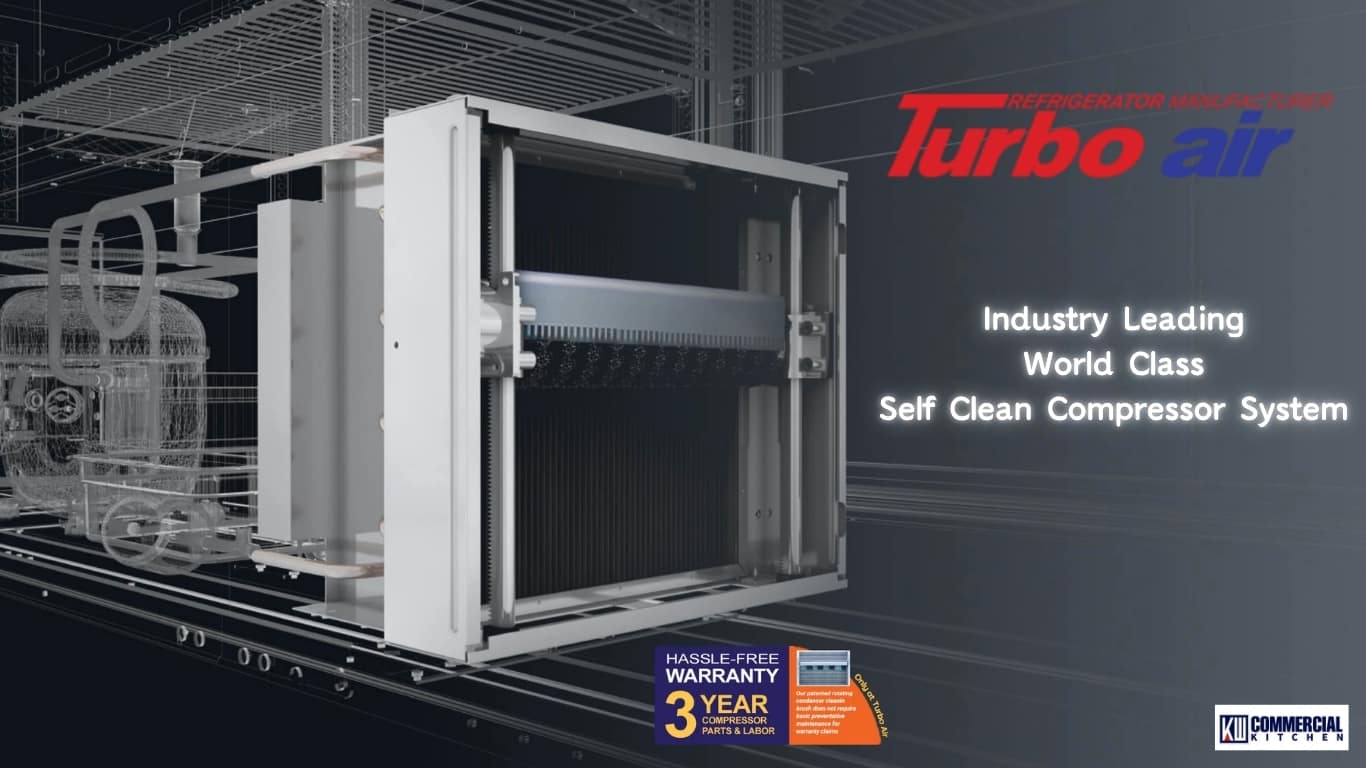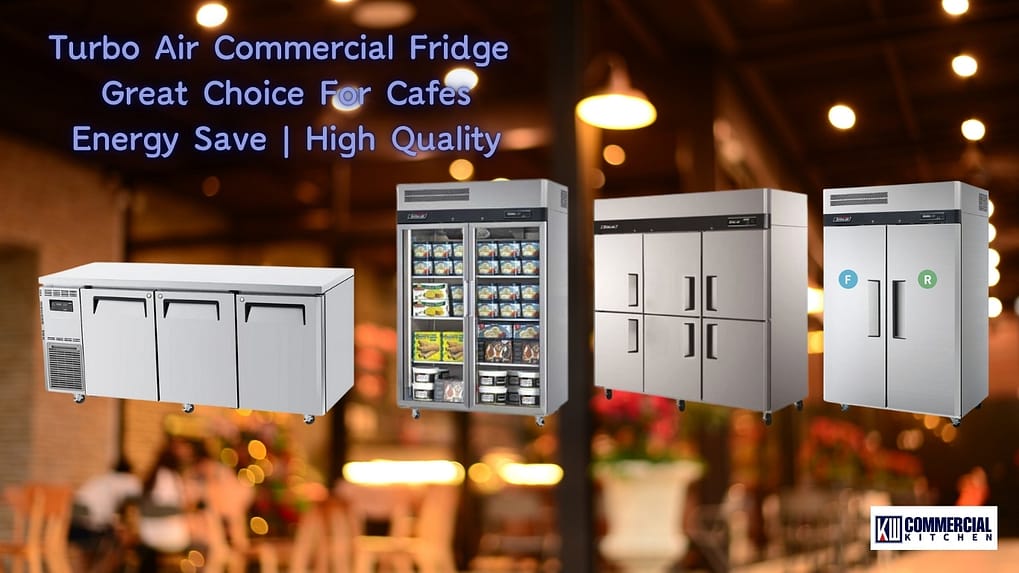Café Refrigeration 2025: The Australian Buyer’s Guide (with Turbo Air picks)
Built for busy espresso bars and brunch lines. No fluff — just the rules you must meet, the specs that matter, the maths behind running costs, and model picks that fit real café workflows in Australia.
Executive summary (60–90 seconds)
- What changed: Australia’s updated Greenhouse and Energy Minimum Standards (Refrigerated Cabinets) Determination 2024 commenced on 5 Oct 2024. It streamlines compliance and clarifies test pathways; star labels remain not mandatory for refrigerated cabinets. Focus on picking the correct cabinet category and climate class rather than worrying about “missing stars”.
- Food safety: Keep potentially hazardous food at ≤ 5 °C (or ≥ 60 °C hot). If food leaves temperature control during prep or display, apply the 2-hour/4-hour rule; time is cumulative.
- Refrigerants: Natural refrigerants such as R290 (propane) are now mainstream and carry very low GWP compared with legacy HFCs (Australia references AR4 values for HFC reporting).
- Why Turbo Air makes the shortlist: patented Self-Cleaning Condenser to reduce dust build-up in café environments, widespread use of R290 across the AU line-up, and an Australian 3-year parts & labour warranty via local channels — backed by real product pages and KW Commercial support. Explore Turbo Air at KW Commercial.
What You Must Comply With (Plain English)
Before you choose a café fridge in 2025, make sure it can meet these Australian standards and regulatory requirements — they’re the baseline for safe, legal, and efficient operation.
| Topic | What the Rule Says | Why It Matters | Official Source |
|---|---|---|---|
| Cold Holding | Keep potentially hazardous food at ≤ 5 °C (or ≥ 60 °C hot). If food is outside temperature control, apply the 2-hour/4-hour rule; time is cumulative. | Maintains food safety, prevents bacterial growth, and is a key point in inspections. | FSANZ: 2-hour/4-hour rule |
| Cooling Hot Food | Cool from 60 °C to 21 °C within 2 hours, then from 21 °C to 5 °C within 4 hours. | Ensures food passes quickly through the “danger zone” where bacteria multiply fastest. | FSANZ: Cooling & Reheating Food |
| Energy Regulation | Australia’s GEMS (Refrigerated Cabinets) Determination 2024 commenced 5 Oct 2024. Minimum Energy Performance Standards are assessed via Energy Efficiency Index (EEI). Energy Rating Labels are not mandatory for this product class. | Guarantees energy efficiency, ensures fair performance comparisons, and meets legal supply requirements. | Energy Rating: Refrigerated Cabinets |
| Product Scope | “Refrigerated cabinets” include refrigerated display, drinks and storage cabinets, ice-cream freezers, and scooping cabinets. | Clarifies which refrigeration products must meet the GEMS requirements. | Energy Rating: Scope & Definitions |
| Refrigerants | Australia uses AR4 Global Warming Potentials (GWP) for HFC reporting. R290 (propane) is a non-HFC refrigerant with very low GWP. | Supports sustainability goals, reduces environmental impact, and aligns with the national HFC phase-down. | DCCEEW: Refrigerants GWP List |
Brand Advantage in Compliance
Meeting Australian compliance standards is easier when your refrigeration works with you. Turbo Air’s patented Self-Cleaning Condenser automatically brushes dust off the condenser coil multiple times a day. This helps:
- Maintain optimal airflow for consistent ≤ 5 °C holding temperatures — essential for FSANZ compliance.
- Preserve Energy Efficiency Index (EEI) performance over time, supporting GEMS energy regulations.
- Reduce manual maintenance and costly breakdowns from clogged coils.
- Lower running costs by keeping the refrigeration system operating at peak efficiency.
Combined with natural R290 refrigerant and an Australian 3-year parts & labour warranty, Turbo Air is designed to keep cafés compliant, efficient, and service-ready. Explore Turbo Air models.
Fridge Types for Cafés – Strengths, Trade-offs & Best Placement
Different café layouts and service styles call for different refrigeration setups. Here’s how to match the right fridge to your workflow — and where Turbo Air’s features can give you the edge.
Upright Merchandisers (Front of House)
Best for: bottled drinks, grab-and-go desserts, impulse buys.
Strengths: High product visibility, easy stock checks, encourages upselling.
Trade-offs: Frequent door openings during peak service can cause bigger temperature swings — choose a unit with the right climate class for your ambient conditions.
Turbo Air advantage: Turbo Air KR45-2G-HC Display Fridge combines clear glass doors for merchandising with the patented Self-Cleaning Condenser to keep cooling consistent and energy efficiency high, even with heavy FOH use.
Underbench / Underbar (Espresso & Prep)
Best for: milk storage at the coffee machine, quick-access mise en place.
Strengths: Saves valuable bench space, keeps essentials within arm’s reach.
Trade-offs: Ventilation is critical in tight bays — honour manufacturer clearance specs to avoid overheating.
Turbo Air advantage: The Turbo Air Undercounter 1-Door 3-Drawer Freezer is front-breathing for placement flexibility and uses the Self-Cleaning Condenser to minimise coil dust build-up, keeping performance stable.
Dual-Temperature Reach-ins (One Footprint, Two Jobs)
Best for: small back-of-house areas where you need both chilled and frozen storage in one cabinet.
Example: Turbo Air Upright Dual-Temp Top-Mount — fridge and freezer compartments in a single footprint, fitted with the patented Self-Cleaning Condenser for reduced maintenance and longer-lasting EEI efficiency.
Strengths: Consolidates two units into one footprint; ideal for space-limited sites.
Trade-offs: Ensure the internal capacity and shelving plan match your busiest service needs.
Prep Counters (Saladette / Sandwich)
Best for: brunch lines, salad bars, and sandwich prep.
Strengths: Keeps ingredients cold and close to hand during service.
Trade-offs: Always keep lids closed when idle; pan depth can affect airflow and recovery times.
Turbo Air advantage: The Turbo Air KHR18-3 Salad Prep Table uses R290 refrigerant for energy efficiency and stable GN pan cooling, helping maintain FSANZ-compliant holding temperatures during peak prep.
Cake & Pastry Displays
Best for: balancing visual merchandising with temperature stability for cakes, pastries, and chilled desserts.
Strengths: Enhances presentation while keeping products within FSANZ cold-holding limits.
Trade-offs: Monitor humidity control and overnight pull-down to avoid drying out delicate items.
Back-of-House Storage Cabinets & Freezers
Best for: bulk dairy, frozen stock, and prep back-ups.
Strengths: Maximises storage away from customer areas; supports FOH replenishment.
Trade-offs: Measure doorway widths and delivery paths before purchase — large units may require disassembly to fit through.
Turbo Air advantage: Upright storage cabinets with the Self-Cleaning Condenser maintain airflow and EEI performance in dusty BOH environments. See Turbo Air storage cabinets.

Climate Class & Ambient – Match Your Café’s Conditions
Climate class is the test-room ambient temperature and humidity used to certify a refrigeration unit’s performance. Choosing the right class ensures your fridge maintains safe food temperatures even during peak service.
| Climate Class | Test Ambient (°C / RH) | Best Placement | Notes |
|---|---|---|---|
| Class 3 | 25 °C / 60% RH | Air-conditioned FOH or BOH | Common baseline for display cabinets; good for cooler, stable environments. |
| Class 4 | 30 °C / 55% RH | Warm kitchens or busy FOH with frequent door openings | Better recovery time after door openings; common for café service areas. |
| Class 5 | 40 °C / 40% RH | Very hot kitchens, non-air-conditioned prep areas | Maximum ambient tolerance; may use more energy to maintain temp. |
Energy & Running-Costs – Simple Café Calculator
Electricity costs add up quickly in a busy café. Use this simple calculator to compare Turbo Air models and see how much you could be spending each year on refrigeration. Figures below are based on published kWh/24h data and an example electricity rate of $0.30/kWh. Replace with your actual tariff for a precise estimate.
| Model | Capacity | kWh / 24h | Approx. kWh / Year | Est. Annual Cost @ $0.30/kWh |
|---|---|---|---|---|
| Turbo Air KR45-2G-HC Display Fridge | 1215 L | 2.63 | ~960 | ~$288 |
| Turbo Air Undercounter 1-Door 3-Drawer Freezer | 374 L | 1.80 | ~657 | ~$197 |
| Turbo Air Upright Dual-Temp Top-Mount | Fridge 222 L / Freezer 242 L | 3.99 | ~1,456 | ~$437 |
| Turbo Air KHR18-3 Salad Prep Table | 500 L | 2.10 | ~766 | ~$230 |
Editor’s Picks 2025 – Turbo Air Models for Australian Cafés
We scored each model using a transparent rubric to help café owners choose refrigeration that will last, save energy, and perform under real service conditions.
Our Scoring Rubric
- Temperature stability (30%) – Holds ≤ 5 °C even during rush hours
- Energy & MEPS/EEI compliance (25%) – Meets or exceeds Australian standards
- Serviceability (15%) – Easy to clean and maintain
- Hygiene & build quality (15%) – Stainless construction, easy-clean design
- Fit-for-purpose in cafés (15%) – Size, layout, and features suited to café workflows
| Category | Model | Capacity | kWh / 24h | Climate Class | Why It Fits Cafés |
|---|---|---|---|---|---|
| Front-of-House Merchandising | Turbo Air KR45-2G-HC Display Fridge | 1215 L | 2.63 | Class 4 | High-visibility glass doors; Self-Cleaning Condenser keeps performance stable despite frequent door openings. |
| Underbench / Barista Station | Turbo Air Undercounter 1-Door 3-Drawer Freezer | 374 L | 1.80 | Class 4 | Front-breathing design for tight spaces; Self-Cleaning Condenser reduces maintenance near dusty coffee grinders. |
| Dual-Temperature Reach-in | Turbo Air Upright Dual-Temp Top-Mount | R 222 L / F 242 L | 3.99 | Class 4 | One footprint for fridge + freezer; Self-Cleaning Condenser helps maintain EEI efficiency long-term. |
| Prep Counter | Turbo Air KHR18-3 Salad Prep Table | 500 L | 2.10 | Class 4 | R290 refrigerant for energy efficiency; maintains safe GN pan temps during busy brunch service. |
Installation & Maintenance Checklist
Correct installation and regular maintenance are essential for keeping your café fridge performing efficiently, staying FSANZ-compliant, and maximising its lifespan.
| Category | Key Actions |
|---|---|
| Site & Access |
|
| Electrical & Ventilation |
|
| Food Safety Rhythm |
|
| Care & Cleaning |
|
Frequently Asked Questions (FAQs)
| Question | Answer |
|---|---|
| What temperature should a café fridge run at? | For potentially hazardous food, your fridge must hold ≤ 5 °C. If food is outside temperature control, apply the 2-hour/4-hour rule (time is cumulative). |
| Do café display fridges need to meet MEPS? | Yes. Refrigerated cabinets in Australia are regulated under the GEMS (Refrigerated Cabinets) Determination 2024, which uses the Energy Efficiency Index (EEI) to assess compliance. |
| Is an Energy Rating Label required on my fridge? | No. Energy Rating Labels are not mandatory for refrigerated cabinets, but performance must still meet GEMS requirements. |
| What is R290 refrigerant and is it safe? | R290 (propane) is a natural refrigerant with very low Global Warming Potential (GWP) and high efficiency. It is widely used in modern commercial fridges and is safe when equipment is installed and serviced by licensed technicians. See DCCEEW refrigerants GWP list. |
| What is the Self-Cleaning Condenser? | Turbo Air’s patented Self-Cleaning Condenser uses a rotating brush to remove dust and debris from the condenser coil daily, helping maintain stable cooling, energy efficiency, and reducing costly breakdowns. |
Sources & Further Reading
- FSANZ: 2-hour/4-hour rule – Official guidance on time-temperature control for food safety.
- FSANZ: Cooling & Reheating Food – Requirements for cooling hot food safely.
- Energy Rating: Refrigerated Cabinets – GEMS 2024 compliance details and scope.
- DCCEEW: Global Warming Potential values for refrigerants – Official refrigerant data including R290.
- Turbo Air at KW Commercial – Full range of Turbo Air commercial refrigeration for Australian cafés.

